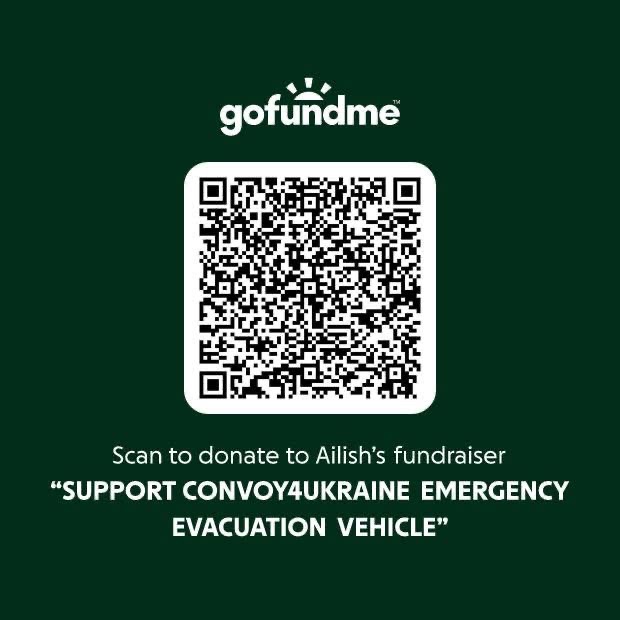

Convoy #10 was Convoy4Ukraine’s biggest convoy yet, and the weeks leading up to departure on 8 September had been a whirlwind of activity as vehicles and different forms of aid were sourced, purchased, checked, overhauled, and finally packed ready for the journey.
Thanks to the generosity of our supporters and the enthusiasm of a team of over 40 volunteers, Convoy #10 saw a record total of 22 vehicles – including 18 4x4s, an ambulance, two vans, and a minibus – head out to our partners in Ukraine. Each was crammed full of aid, from vital medical supplies like tourniquets and bandages to much-needed items like generators and power banks, of which there is always a shortage. We also took more everyday items like shampoo and teabags, bound for the Phoenix Centre, a community for internally-displaced refugees in Lviv. A university department in Cambridge was even refitting their building, so we were literally able to bring the kitchen sink (as well as much of the rest of the kitchen).
Two days earlier, we’d packed the vehicles to capacity, and occasionally beyond; three 4x4s made the journey of 1,250 miles with medical stretchers (very firmly) strapped to their roof bars. Imagine that MC Escher had developed a fascination with 3D Tetris and you’ll get the idea. A large consignment of muesli and tea bags was distributed around every available gap to make sure that even the smallest leftover space wasn’t wasted.
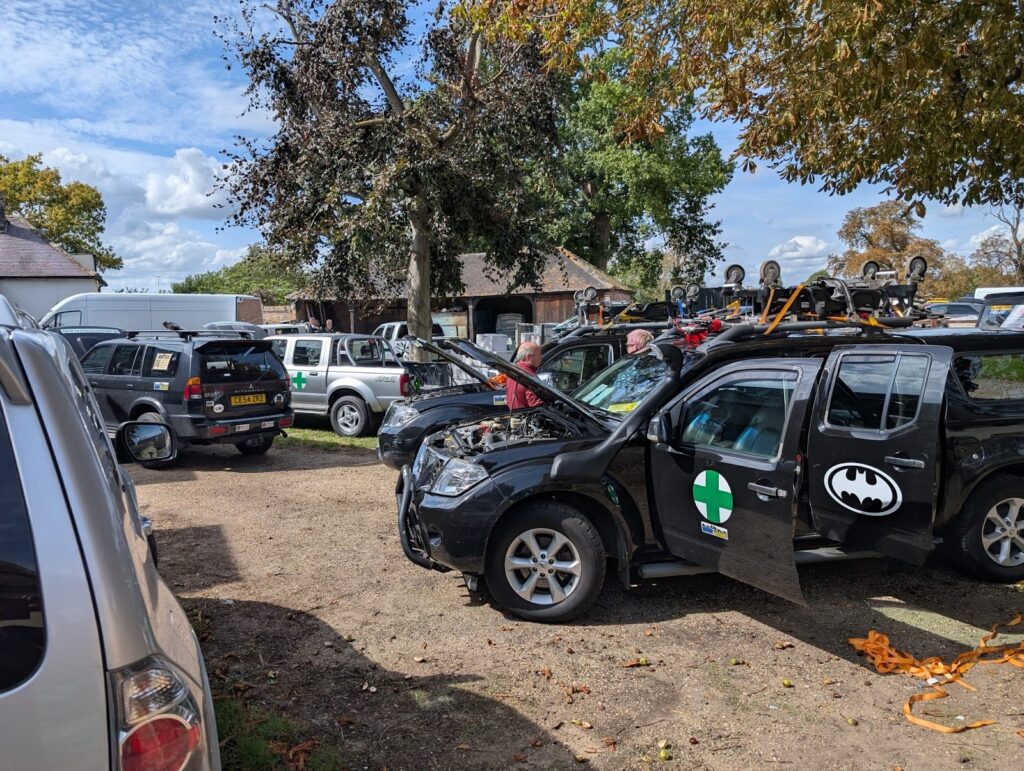
Most of the vehicles started out early on Monday morning, with roughly half coming from Cambridge. The trip down to Dover was uneventful, and after dealing with some port bureaucracy (who knew that fire extinguishers could pose a fire risk?), we enjoyed a smooth crossing. This was the first time the whole group of UK volunteers had come together in one place. Around half the team were on their first convoys, so there were plenty of new introductions, as well as reunions from those who had been on previous convoys.

A couple of hours later, as we arrived in Dunkirk, we hopped back in our vehicles and started the journey to our first overnight destination, clipping the corner of France before crossing the majority of Belgium to arrive at our hotel in Antwerp in the late afternoon.
A short tram ride brought us to the centre of the old city, where we met up with the team of Irish drivers, who had set out a day earlier with five vehicles and arrived around midday. Everyone got acquainted over a drink and a decent meal after a long day’s driving, and then we headed for bed.
The next day started with an early breakfast, as well as checking oil, coolant, and tyres in what would become a well-worn ritual over the coming week.
After a decent run the day before, the weather turned. Torrential rain slowed us down as we made our way through the Netherlands and towards Gottingen, roughly in the centre of Germany.
Worse, we also experienced our first casualty. The turbo on one of the Irish trucks gave out, necessitating a lengthy stop in Dusseldorf to source and fit a new one – a job that took many hours and the combined expertise of all three of the convoy’s mechanics.
Happily, the weather brightened in the afternoon, and we were able to take advantage of the smooth German motorways. Most of us arrived at the hotel early enough to enjoy some downtime, which even included a swim, since there was a pool in the basement. (It’s not entirely clear how Jamie managed to organise hotels that were quite so nice given the rock-bottom prices, but he clearly missed a calling as a travel agent.)
In the evening, we again took a tram into the city centre, and enjoyed a delicious German meal and a beer or two at a little restaurant, before heading back to the hotel.
After breakfast, the obligatory vehicle checks, and our standard 8am briefing from Brian, all 22 vehicles started out on what would be the longest day of driving: over 600km, or almost 400 miles. Despite the distance, there were few problems. The vehicles – including one with a shiny new turbo – all held up well, and Polish motorways are even better maintained than German ones.
The general rule on Convoy is that, while everyone leaves at roughly the same time, we all travel at our own pace, stopping when and where we want. Everyone downloads Life360, an app that allows us to track where each person (and vehicle) is on the road, in case of any problems. Since we all follow the same route and the service stations are relatively infrequent, it’s easy to check who’s around and hang out together on breaks. One of the little joys of each day was pulling in to fill up on diesel and adjust personal fluid levels, and seeing a line of trucks with Convoy4Ukraine stickers parked up.
While it’s smart to keep your wits about you on the Polish motorways (drivers don’t give you a lot of leeway when they’re overtaking), the route was easy and we all arrived in Wroclaw by late afternoon. By then, it had started raining again, and most of the group opted to eat in the hotel. At this point, we were almost a thousand miles into the journey, with well over three-quarters of the total distance behind us.
The last major day of driving was a fairly easy one. Once we passed Krakow, the roads became quieter, opening up into big, wide plains, far more sparsely populated. Even the light is different. We started to see more Ukrainian vehicles, and more military transports. They’re subtle changes, but combine to give a sense that things are different on this side of Europe.
It’s a tradition on convoys that on the final evening before crossing into Ukraine, everyone eats together at an Irish steakhouse in Rzeszow. Come 7pm, we piled into a series of taxis and spent a fantastic evening enjoying some outstanding food and company.
We were joined at the steakhouse by Sasha and Vika, who head up the Sunflower Network. Their connecting flight from the US had been delayed in Berlin, but they had somehow managed to find a replacement. The Sunflower Network is the organization that liaises with Ukrainian groups on the ground, making sure that all the vehicles and aid we source goes to the right places – crucial for ensuring maximum impact, and that every pound is spent well.
It was an earlier start than usual on Friday, since it pays to get to the border early. Upon getting into our vehicles just after 7am, though, one of our drivers hit a snag. His truck wouldn’t start, and even the best efforts of our mechanics couldn’t change that. In the end, there was nothing for it but to break out the tow ropes and haul the vehicle the last 50km – not much fun for either driver when leaving the city in rush hour.

We later found out that the teeth on the timing chain sprockets had broken off, causing the chain to slip. This typically causes a cascade of further damage, putting the vehicle permanently out of action.
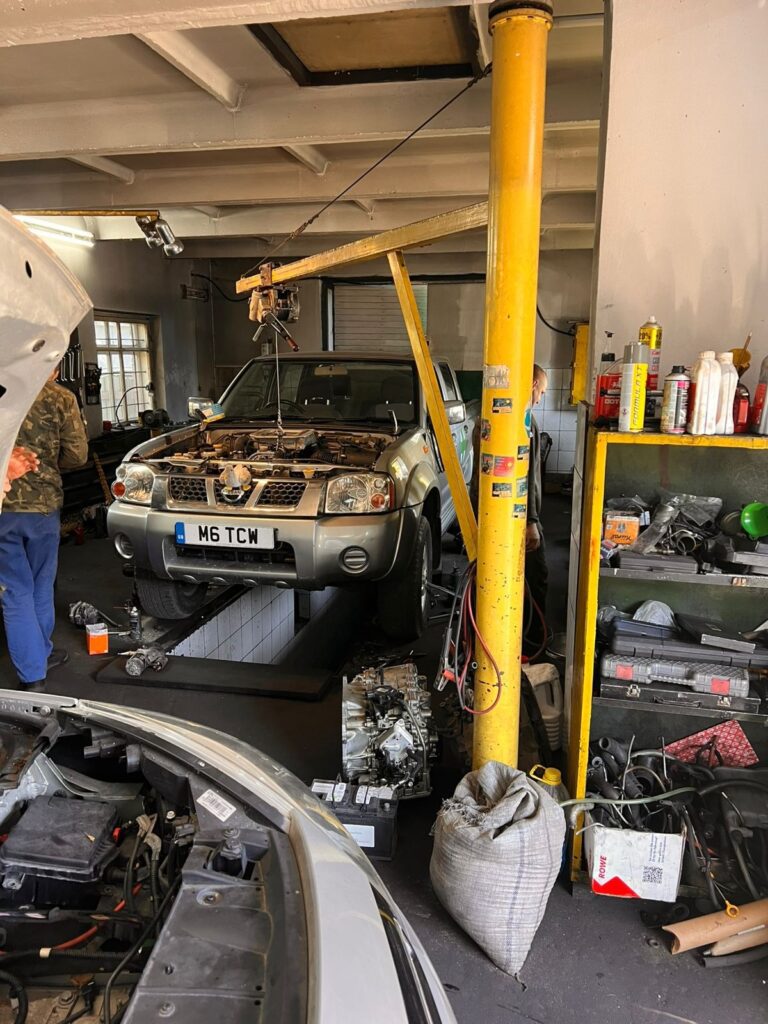
Happily, the ingenious Ukrainian mechanics who ultimately received the vehicle were either unaware of the seriousness of the damage, or chose to ignore it, and promptly fixed it anyway.
At the border, the Polish authorities didn’t seem to know what to make of a convoy of 22 vehicles trying to cross into Ukraine. We waited for several hours, enduring various forms of bureaucracy, before being processed in groups of three or four. Although the Ukrainian side was much faster (and more friendly, largely thanks to Vika’s team of Ukrainian helpers), it was well into the afternoon by the time the last group of 4x4s finally got through.
The drive to the handover point at a hotel in Mostyska, a few miles over the border, was brief – at least after a group of Ukrainian soldiers had temporarily bridged a section of missing road. The feeling of relief as the last 4×4 pulled into the car park was enormous. 40 volunteers, 22 vehicles, and tens of thousands of pounds worth of aid had made it to the finish line in one piece.
Handing over the vehicles and aid was a bittersweet experience. A team of Ukrainian drivers had gathered to meet us. Some were from the Phoenix Centre in Lviv, around 40 miles further east. Others had come from Kyiv, a seven hour drive, and would be driving back almost immediately to ensure they arrived before curfew at midnight. Some were on a short break from the front lines. They were ordinary people, working in extraordinary circumstances, and all intensely grateful not just for the practical help, but for the fact that the rest of the world hasn’t forgotten them.


We were treated to lunch, which was hosted by Mayor Anatoly, and all the more delicious for being served mid-afternoon, as well as speeches, gifts, photos and videos. One comment from Anatoly that stuck with us was that 80% of individuals and organisations who were once engaged with helping Ukraine have now stepped back. Almost four years into the full-scale invasion, it’s harder than ever to keep people’s attention, even in Europe.
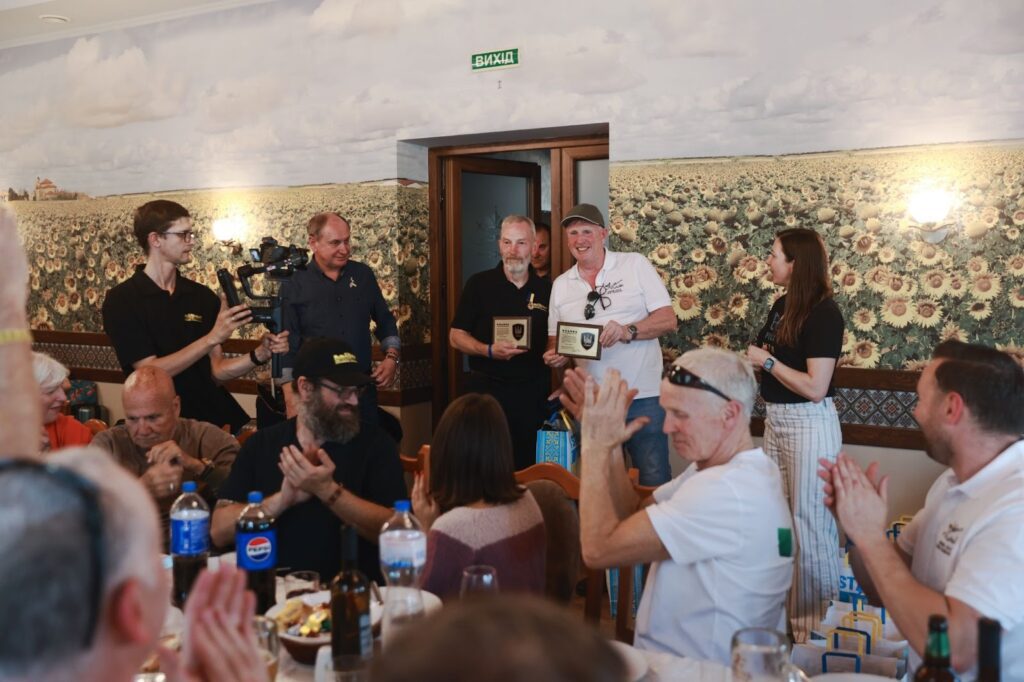
By 5pm it was time to go; the Ukrainian drivers had already left some time ago. Most of the group headed back by minibus to cross the border on foot and take a coach to Krakow, where they spent the night and flew home in the morning. The rest went on to Lviv for an extra night.

Prelude
Wednesday evening. After work, I call into Leonard’s Garage in Gurteeny to collect An Cailín Deas – my convoy 4×4. A 2-litre diesel VW Amarok. My first task is to bring my (honorary)
nephew to football training. He has the proud place of being my first passenger.

Then it’s off to Kilchreest for a physiotherapy session.
The week before departure, I decide it is high time to get my leg sorted. It has been troubling me for the past month, with my right calf in particular giving persistent bother. The first physio session brings some relief, but it is still not right. Jeanette kindly fits in a second session to see me through. Support for humanitarian aid comes in many forms; sometimes it is accommodating a late evening booking for someone working full-time and preparing for a
week-long volunteer driving trip. Her parting words of good luck are accompanied by a warning that I will be very tired and should get an early night. Jeanette’s advice does not go unheeded.
Thursday
I wake from a heavy sleep, still in a stupor. Jeanette had not been joking about how tired I would be. Between dream and waking, I have a distinct sense that I have somewhere to go. Cinderella drifts through my mind – some subconscious link from the past two days that I cannot quite place. I do not have to go to Limerick, as I am working from home today. Then it comes to me – I am going to Ukraine. Not only that, but tomorrow I will be driving from my
home in East Galway to near Lviv.
Today is work: emails, project catch-up. Around midday, with no post arriving, I call Shannon to enquire about the jeep’s logbook. On my second call, the Motor Tax Office confirm it has
been processed and I can collect it tomorrow. This adds an unwelcome two hours’ driving to my Friday plans, but it cannot be helped.
Everything about this journey comes down to timing. The request for assistance arrived in mid-August. The jeep only arrived last Saturday. I collected it yesterday. I leave tomorrow. I
decide not to tell Tom Walston, our convoy leader in Cambridge, about my last-minute paperwork dash. He is fully aware of the schedule, and anyway I have three days to reach
the convoy start line on Monday morning.
My motivation to complete this project could not be higher. The jeep is destined for southern Ukraine, in the Kherson oblast, near the front lines. It is bound for a fire brigade whose trucks have been put out of action – by drone attacks. They need a plain civilian emergency evacuation vehicle, and this jeep is it. They know their neighbours and friends are acutely vulnerable. A house is bombed, the emergency services rush to extinguish the fire, and then
they are bombed again – the objective is maximum casualties, civilian targets. This jeep is for saving lives in rural communities like ours. For them, and for me, this is no small thing.
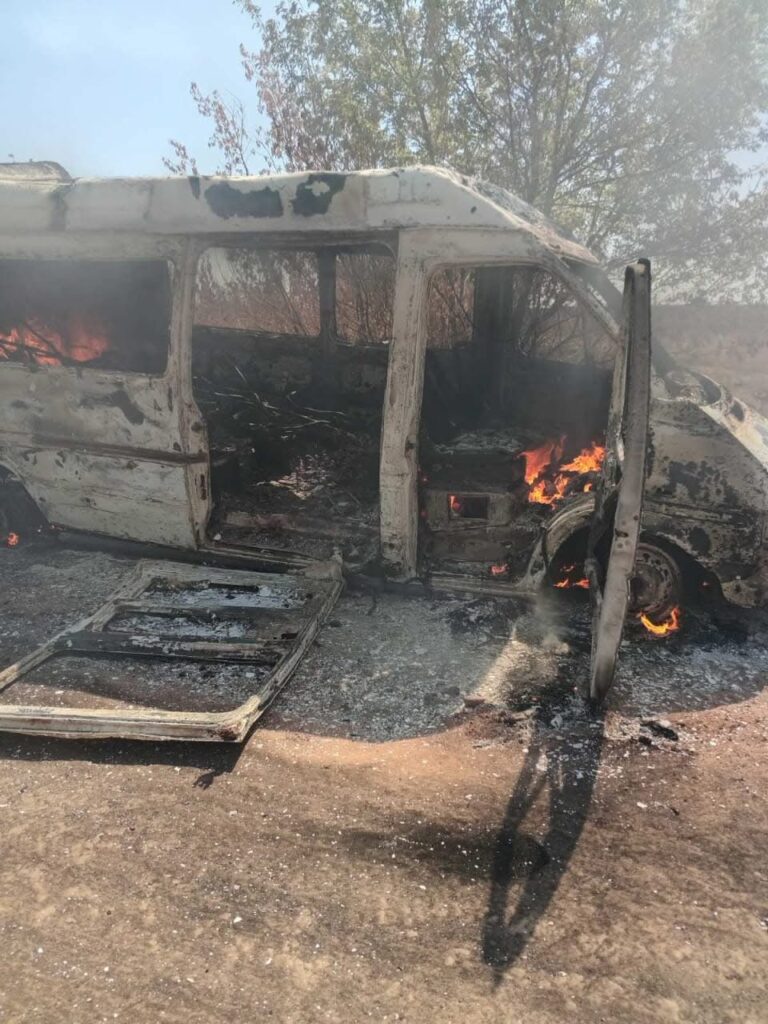
As I sit in my childhood home, it is difficult to imagine it reduced to a shell, or to rubble. All its stories and history gone in an instant. How protected I feel within these great thick walls my
ancestors built. How much they have withstood in its lifetime. How it stands now in a world that has changed so drastically in the past three years. World events move beyond our control. How do I deal with that? By focusing on the practical things; by choosing to act.
This will be my fifth convoy. My eighth visit to Ukraine. Not my first rodeo. Nor my first journey with the others I will meet in Dover and in Antwerp. People like you and me who also choose to act, so that good will prevail. If we want peace in our time, is there ever really any other choice?
Convoy4Ukraine
